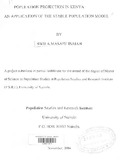| dc.description.abstract | The general objective of the study was to project the Kenyan population to stability. The
study specifically looked at obtaining the projection matrix for Kenya, estimating the stable
age structure for Kenya and comparing the population size, rate of natural increase and the
net reproductive rate ofthe stable population with the current reported and related
demographic indicators. The study data was obtained from the 1999 Kenya population
census.
The study is arranged in five chapters where chapter one deals with the introduction, the
problem statement, objectives, justification, scope and limitation. Chapter two presents the
literature review while chapter three handles the data source and the method of analysis,
specifically giving an in-depth description of the matrix method of population projection.
Chapter four presents the findings of the study and finally chapter five gives the summary
of the findings, conclusions and recommendations both for policy and for further research . . .
The major findings of this study are that under the fertility and mortality rate of the base . population of 2000, the Kenyan population would stabilize by the year 2090 with a
youthful age structure. The dominant latent root of this stable population is 1.183, which
gives the intrinsic rate of natural increase of 0.22% per annum and the net reproductive rate
of 1.0636.The dependency ratio of the Kenyan population will remain high with just a
slight decline of 5% from 76% in 2005 to 71% in the year 2090 at stability. The total
population will increase rapidly to 32.4 millions, 41.8 millions, 62.2 millions, 97.6
millions, 109 millions and 180.6 millions in the years 2005, 2020, 2050, 2090, 2100 and
2145 respectively. Over the same period, the mean age of the female population will be
I
I
23.43 years, 25.33 years, 28.01 years, and 27.95 years 28.02 years, 28.01 years and 28.00
years respectively. This is a clear indication of the ageing population.
A youthful age structure poses greater challenge to the government and presents such high
dependency ratios which enslave the working few to support the rest of the population. The
government is forced to invest in consumer projects like education, food security, and
health, housing and general infrastructure rather than in income generating projects like
industries. Policies should be set up and reinforced to ensure that the economic growth rate
is increasing in direct proportion to the population growth rate in order to achieve national
development. The government should vigorously invest in the efforts to reduce the fertility
levels by supporting family planning programs for this will encourage the population to age
and stabilize with a columnar age structure which usually has a low dependency ratio. | en |

